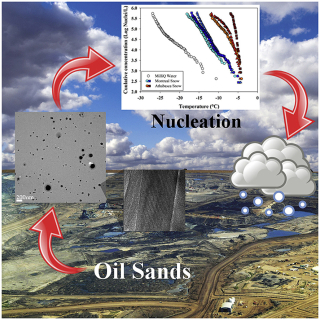
The Athabasca Oil Sands Region (AOSR) in Alberta, Canada, is an important source of atmospheric pollutants, such as aerosols, that have repercussions on both the climate and human health. We show that the mean freezing temperature of snow-borne particles from AOSR was elevated (−7.1 ± 1.8 °C), higher than mineral dust which freezes at ∼ −15 °C and is recognized as one of the most relevant ice nuclei globally. Ice nucleation of nanosized snow samples indicated an elevated freezing ability (−11.6 ± 2.0 °C), which was statistically much higher than snow-borne particles from downtown Montreal. AOSR snow had a higher concentration (∼2 orders of magnitude) of >100 nm particles than Montreal. Triple quadrupole ICP-(QQQ)-MS/MS analysis of AOSR and Montreal snow demonstrated that most concentrations of metals, including those identified as emerging nanoparticulate contaminants, were much more elevated in AOSR in contrast to Montreal: 34.1, 34.1, 16.6, 5.8, 0.3, 0.1, and 9.4 mg/m3 for Cr, Ni, Cu, As, Se, Cd, and Pb respectively, in AOSR and 1.3, 0.3, 2.0, <0.03, 0.1, 0.03, and 1.2 mg/m3 in Montreal snow. High-resolution Scanning Transmission Electron Microscopy/Energy-dispersive X-ray Spectroscopy (STEM-EDS) imaging provided evidence for various anthropogenic nano-materials, including carbon nanotubes resembling structures, in AOSR snow up to 7–25 km away from major oil sands upgrading facilities. In summary, particles characterized as coming from oil sands are more efficient at ice nucleation. We discuss the potential impacts of AOSR emissions on atmospheric and microphysical processes (ice nucleation and precipitation) both locally and regionally.
Area of Research: Atmospheric Chemistry
This paper was published in Environmental Pollution. Volume 252, Part A, Pages 289-295, 2019. Please see Rodrigo Rangel-Alvaraz, Chelsea Willis, Vince St-Louis, Marc Amyot, Parisa A. Ariya, Athabasca Oil Sands Region Snow Contains Efficient Micron and Nano-sized Ice Nucleating Particles,
Prof. Parisa Ariya is a James McGill Professor of Atmospheric and Interfacial Chemistry, Professor at the Department of Atmospheric & oceanic Sciences as well as the Department of Chemistry at McGill. Her laboratory's research explore major fundamental, and applied research questions on chemical and physical processes involving aerosols, as well as organic and metal pollutants of relevance to the Earth's atmosphere and its interfaces. Our direct research contributions are to the fields of atmospheric sciences and climate change, specifically aerosol-cloud interaction, air pollution, atmosphere-ocean interactions, physical and analytical chemistry, sustainable chemistry and technology, nanoscience, environmental health and medicine.